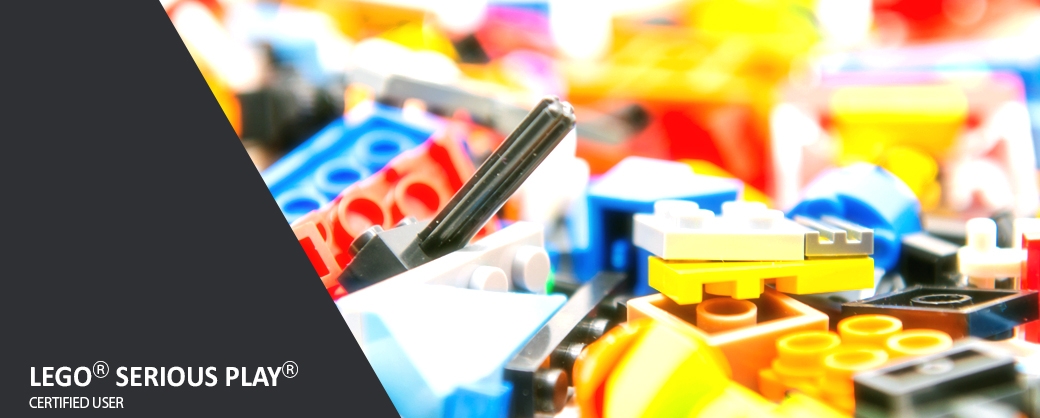Lego Serious Play
Tell me and i’ll forget. Show me and i may remember. Involve me and i’ll understand.
(Chinese
proverb)
You know it. Serious-looking faces at a meeting where only the “Pareto 20 percent” take part in the debate – until the moment a burning issue comes up, raising a conflict of interests, and all prospects for a constructive discussion are over… Maybe this is why meetings and working groups are often but an “unavoidable evil” yielding no effective process or desirable benefits.
They say one picture says more than a thousand words – if this is true, then a three-dimensional model must provide at least three times as much information. Moreover, if the model is strongly coloured, easy to build, eliminating stress and bringing the joy of “building a model of one’s own” (a metaphoric representation of one’s own perspective) and a story behind it where every “builder” has their own truth – then you get an authentic and fruitful insight into the problem being solved.
Lego® Serious Play® (LSP) is a flexible tool for communication and reviewing situations being solved, creating new perspectives and often surprising results. Maybe this is the reason why the age of excess information and environmental complexity finds the method more and more popular and used by all manner of organisations, from NGOs to global corporations and government agencies such as NASA.
As the name suggests, the process involves Lego bricks – a special set of pieces of a wide range of colours, including translucent. The set includes bricks of various shapes, from the 2x1 through a range of slanted formats; but also plants, flowers, trees, cars, and animals (including elephants, monkeys, owls etc.); a series of mini figures with changeable head gear or hair covers and changeable facial expressions for both genders; and also black cobwebs, signs and gold money that are intentionally designed not to be connected to any other pieces. One brick can lay a foundation stone to an entire story.
Lego Serious Play was created by Johan Roos and Victor Bart, two professors of the Switzerland’s Institute for Management Development, and Kjeld Kristiansen, Lego Group leader. In their original intent, the methodology authors were seeking to help top managers in the first place in creating or reviewing their business strategies. Lego bricks, however, have proved their justified use also in modelling everyday business operations, mapping opportunities and threats, improving the work of teams and processes, introducing new products/processes/principles on the market and to companies, and complementing the development of interpersonal and managerial skills.
WHY IT WORKS
As demonstrated by many qualitative studies and researchers using the LSP, the use of construction-type of work in projections provides high effectiveness. The key is that in constructing, one taps into the inner image or subconscious meaning, as in dreaming, and gets on straight to building a 3D model – thereby bypassing the need to talk about their ideas or put them on paper. Model building is often limited by a moderator in order for the participants to perceive the task as a challenge and get into the “flow” – a mental state when a person is completely preoccupied with an activity, staying motivated and focused on the process. Time consumption is one of the basic preconditions here because what matters in model building is not technical refinement or aesthetics of the models – it is working with metaphors. 3D visualisations focus discussion while words become secondary or even useless altogether. This is why shy or less expressive people can feel safe to get involved, too – increasing participation of all attendees. In this way, we avoid the standard form of meetings with only a small part of participants being involved. In addition, the model/construction stands for a reference point where the solution to the situation moves from the personal level to a discussion about models, which helps eliminate possible conflicts that may arise from personal interests or differing views due to misunderstandings. When building, we use both hands, engaging both hemispheres of the brain. The right hand engages the left part of the brain and the left hand activates the right one. The construction process combines the use of rational, analytical work of the left hemisphere with the intuitive, synthetic activity of the right hemisphere. Building with both hands stimulates such parts of the brain which are otherwise inaccessible.
HOW IT WORKS
The Lego Serious Play methodology takes advantage of the close link between the hands and the brain. Moderated by a facilitator, it is a very structured and powerful process with a clear concept and structure of questions. This helps retrieve the information that is rich in nature and stored deeply within the participants, so the process is much more than just playing with Lego. An LSP workshop is governed by a set of fundamental principles that are included in the so-called Lego Etiquette:
- The facilitator gives a set of “art assignments”, with
every assignment call beginning with the word: “Build...”
- The facilitator gives an assignment and the
participants respond by building models shown in the metaphor.
- Then they tell EVERYONE in the group a metaphorical
story behind their model.
- All get down to building their models on individual
basis, giving meaning to the models as they go.
- A partial assignment ends with questions, previews,
observations, reflections, and pattern identification.
Levels of reflection for individual assignments are gradually increasing to ensure the workshop is running smoothly and the participants are constantly preoccupied with the tasks.
It is important to make sure all assignments are stimulating enough for the trainees to create ideas and stories while neutral enough to eliminate any hidden or first-plan agenda of the workshop sponsor or facilitator that might hinder creativity. The Etiquette requires that everyone in the room build and tell a story behind their model. We always start with building several models individually and only after that, the participants get on to building models together. The role of the facilitator is to ensure that a participant’s key idea is included in the shared work, too. In the end, the facilitator would help by asking questions about the models. (The questions may go like this: “What is this green brick on the head? What is the meaning of the cobweb between the monkey and the figure wearing a crown? Show me in your model where exactly there is distance between the two departments?”).
WHEN TO USE THE LSP AND WHAT YOU GET
Lego Serious Play is a creative technique used to acquire authentic expression in challenging topics, for instance:
· When a problem or a task is complex and multilayered and/or the answers are not clear.
· When you need to create a broader perspective to see the big picture and explore other options and solutions.
· When a task requires the solution to be seen from a new, unconventional perspective.
· When the issue on the table is difficult or hard to discuss, or when there is too much emotion among the participants.
· When a group is inhomogeneous in terms of age, professional specialisation, level of skills advancement, or hierarchical structure.
As we have said before, there are three levels of potential LPS uses at work, from individual to organisation-wide goals:
· Individual: Happiness and contentment – couching, individual consultations, development plans, and achieving the visions of managers/employees/clients;
· Team: Synergy and trust – teambuilding, department-based problem solving, department performance increase;
· Organisation: Mission accomplishment – strategy, goals, long-term future, process setting.
So, what do you get?
· Greater involvement and engagement of participants;
· More thoughts and ideas;
· More emotions and passions, void of negative emotions or escalated conflicts;
· A feeling of commitment and trainee participation;
· Better (quality) results and “out-of-box” solutions.
And that is worth the experience because the LSP is both process- and result-oriented. If you want to learn more about the LSP or experience it first-hand, please contact me.
Roman Kurnický
Managing Partner & Principal Consultant
RecruitMen & Developium Group






